Summer campaign 2017
In 2017, fieldwork in Sikyon was carried out in late June and July and was primarily dedicated to excavations. It also included again geophysical investigations (by W. Rabbel, K. Rusch and H. Stümpel/Institute of Geosciences, Christian-Albrechts University of Kiel), a geoarchaeological survey (by Chris Hayward/University of Edinburgh) and the study of architectural blocks.
The geoarchaeological survey comprised searches for quarries within the vicinity of the ancient city, searches for potential sources for oolitic limestone in the surroundings as well as the study of the stone varities in the architectural remains of the old town. It was possible to identify significant quarry traces of a soft bio-oosparrite (Fig. 23) and of conglomerate. Conglomerate was largely used in the architectural structures of Sikyon, while no archaeological remains using bio-oosparrite are yet known in Sikyon. Oolitic limestone was used in Old Sikyon in large numbers of architectural remains, but initial prospections in eastern Sikyonia did not show evidence of quarrying of this stone variety. Observation of stone materials in a pile of blocks next to the chapel of Agia Varvara as well as in the architectural remains of the recent rescue excavations along the national road Athens-Patras yielded a variety of lithologies, often combined in the same structures.
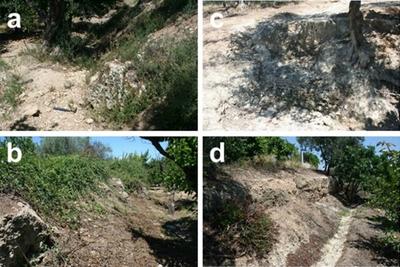

Geomagnetic prospection (Fig. 24) was continued in order to define more precisely the borders of the settled area of Old Sikyon in the north, north-east and east. The area of the settlement of Sikyon amounts to around 1.55 square kilometres (155 hectares) including suburban areas with thinner traces of occupation (Fig. 25). Furthermore, geomagnetic and resistivity survey helped to provide further indications for the likely course of the city wall north of the town and for the course of one of the main streets connecting the city to its harbour in the direction of the plateau. Additionally, intensified resistivity survey on selected fields helped to generate a 3D-geoelectric picture, which will be very useful for comparison with excavation results. The topography of the harbour was further investigated as well: The processing of the data generated seismic profiles in 2016 indicates a former water inlet of 25-30 m width, which was followed over a larger area by using the H/V (Horizontal-to-Vertical Spectral Ratio) seismic method. The processing of the data is still in progress and promises to yield further valuable information about the form of Sikyon’s harbour.
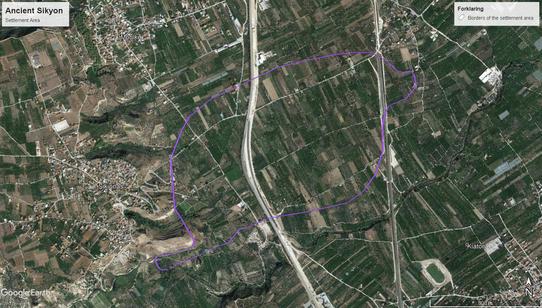
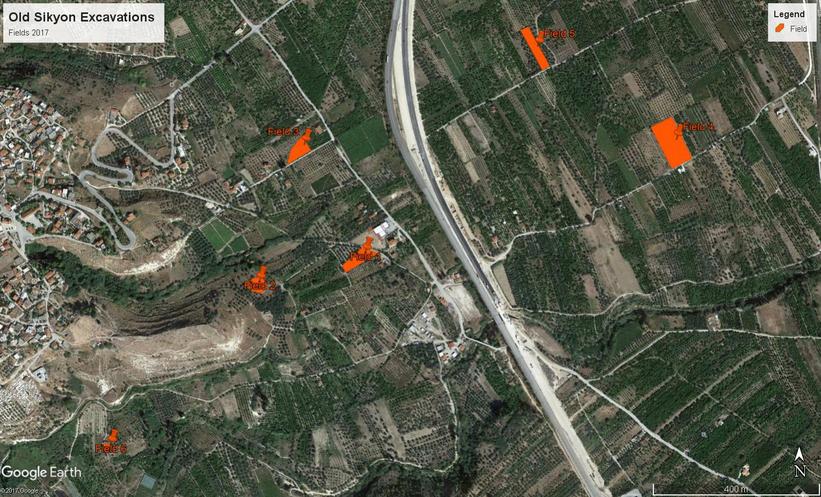
Excavations were conducted in eight trenches on five different fields (Figs. 26-27), which were chosen on grounds of anomalies detected through archaeological survey, geophysical research and remote sensing. The Fields 1 and 2 in Agios Konstantinos are located in the presumed area of the ancient city centre, while Field 3 in Agios Nikolaos is still close to this area. In Field 1, a wall from the late Geometric/early Archaic periods was observed, which represents the oldest architectural remains of Old Sikyon discovered so far, but needs further investigation for interpretation. The wall is accompanied by several cuts from the same period, while later phases are not well represented. Field 2 yielded building structures from the Classical, Late Roman and Byzantine periods in Trench A: a Classical pebble floor with an irregular mix of multi-coloured pebbles in mortar was found, crossed by a Roman or Byzantine wall running from southwest to northeast, while a wall of Byzantine date runs south of it in an east-west direction. In Trench B, another part of a Byzantine wall was found, running roughly northeast-southwest.
After the removal of a huge layer with dense pebble inclusions of yet unclear interpretation in Trench A of Field 3, two parallel walls located roughly 3.5 m apart were discovered. Their character, however, is very different and makes it improbable that they belong to the same construction phase: the southwestern one consists of rough and irregular masory, while the north-eastern wall (probably of Classical date) is made of monumental and finely dressed limestone blocks, which might indicate some important public or cultic building. In Trench B, two small parts of sections of walls (both earlier than the late 4th c. BC) came to light, which run roughly in a right angle, but in the layers excavated so far are not connected to each other. The walls in Field 3 all correspond to anomalies in the geophysical resistivity measurements.
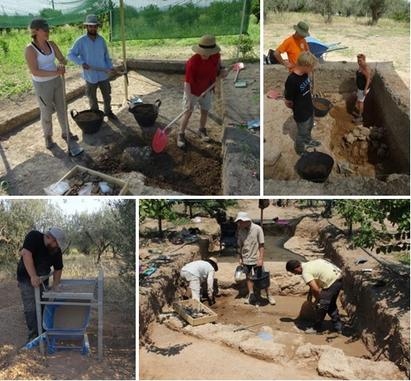
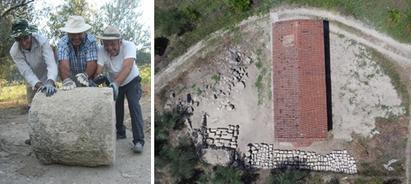
Field 4 and Field 5 are located in more suburban areas. Trench A in Field 4 contains two parallel walls located roughly 4 m apart in an approximately east-west direction, the northern wall consisting of large blocks, while the middle wall combines slab-like blocks with rubble masonry. Between these two walls, a layer with a high pebble concentration needs more investigation. In Trench B (north-east of A), two walls diverging towards the east were unearthed. The northernmost wall combines vertically standing slabs with rubble stones and faces south, while the southern one (running east-west) consists of limestone and conglomerate slabs on a rubble foundation. In the area in between, a large amount of pottery and other finds of the late 4th c. BC was found. South of the southern wall a possible road surface with pebble inclusions was uncovered. The geomagnetic investigations imply a road running north of the northern wall in Trench A and south of the southern wall in Trench B, bordered by walls on both sides. It is obvious that we are dealing here with a border zone of Old Sikyon, with a road leading out of the city in the direction of its harbour, which is also confirmed by the likely presence of graves in its vicinity.
The excavations in Field 5 yielded no architectural structures, but very interesting finds, e.g. coins, obsidian and flint fragments, pottery sherds from the late 8th/early 7th c. BC through to the middle Hellenistic period and fragments of mortar, stucco and mosaic floors, which witness of buildings and show that this area was occupied not only during the time of Old Sikyon, but also thereafter.
In Field 6 in the very south-west of the project’s research area, a huge pile of ancient blocks used as spolia was nearly stripped down to the ground. All the significant architectural blocks (amongst others column drums and Doric frieze blocks) were arranged in a lapidarium (Fig. 28), numbered, described and photographed, and the most interesting blocks were drawn. It turned out that the blocks must have been part of at least two, but probably more ancient buildings, most likely of public or cultic function.
The excavated fields all yielded pottery from the Classical period; and the majority of the trenches also from Archaic times (Fig. 29). Moreover, pottery from the Hellenistic up to the Byzantine periods was found, mostly in the top layers. Late Geometric/early Archaic pottery as well as some examples of Helladic pottery were especially found in Field 1, which indicates that this area was settled during these periods. In Field 2, most of the pottery dates to the 4th c. BC and to the Late Roman and Byzantine periods, while in Field 3, the 5th and 4th c. BC predominate. Field 4 also yielded pottery from the 5th and 4th c. BC in large quantities. In Field 5, finds range from the late 8th/early 7th c. BC to the middle of the 3rd c. BC and also include many minor obsidian fragments. Moreover, eleven coins were found in total, most of them being Sikyonian from the 4th c. BC, but also including examples from later times and other Greek regions being among them. For archaeobotanical studies, many earth samples were taken from the different trenches and flotation was carried out with a newly-built flotation machine (Fig. 29), and the remains are now awaiting further analysis.
With the fieldwork of the 2017 season, we were able to gather much further information about the old town of Sikyon, its geology, topography, urbanistic structure and some of its private, public and cultic buildings. The excavations generated a huge amount of ancient material of all sorts, which already now offers a deep insight in the material culture of the town and yields valuable chronological information. Excavations in Old Sikyon will continue and be expanded within the next two years in order to allow for more precise and extensive information on the infrastructure and urban development, the private, public and cultic architecture as well as the famous art and culture of this major polis in Archaic and Classical times.

